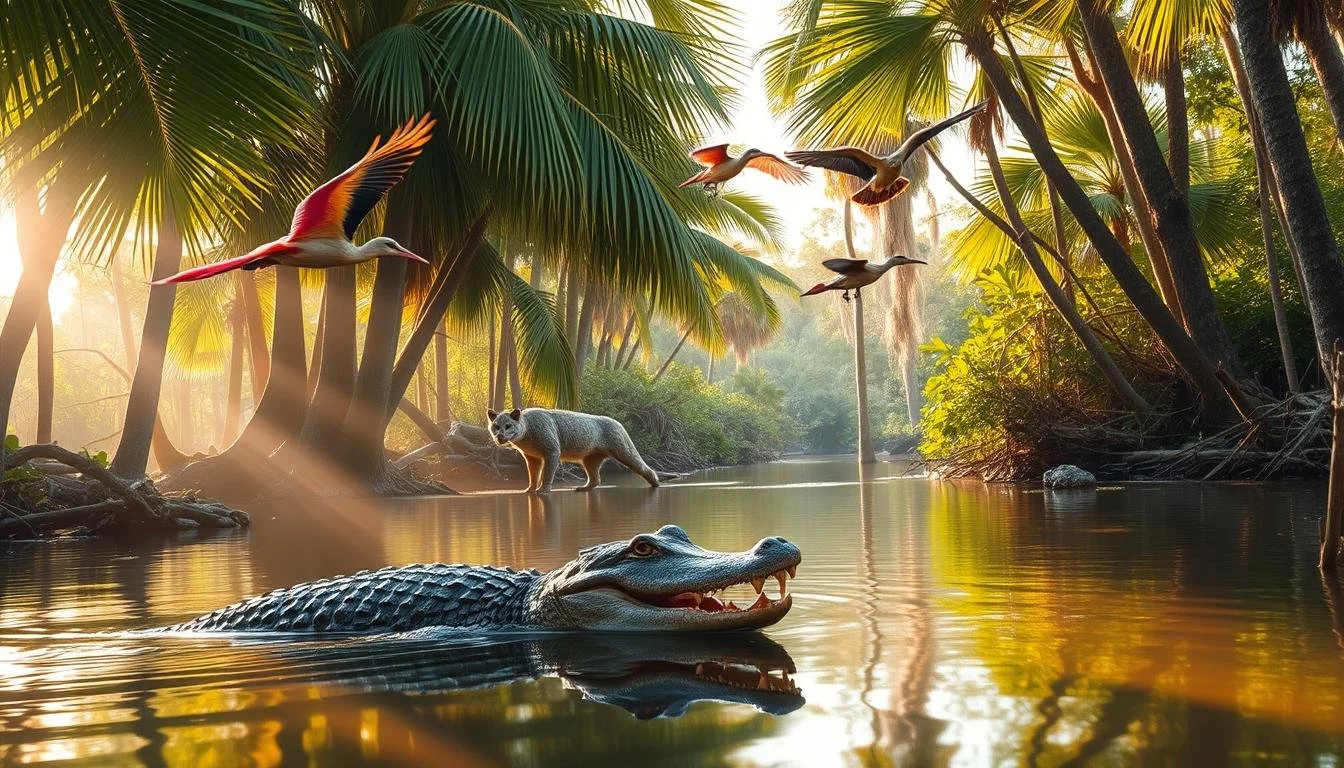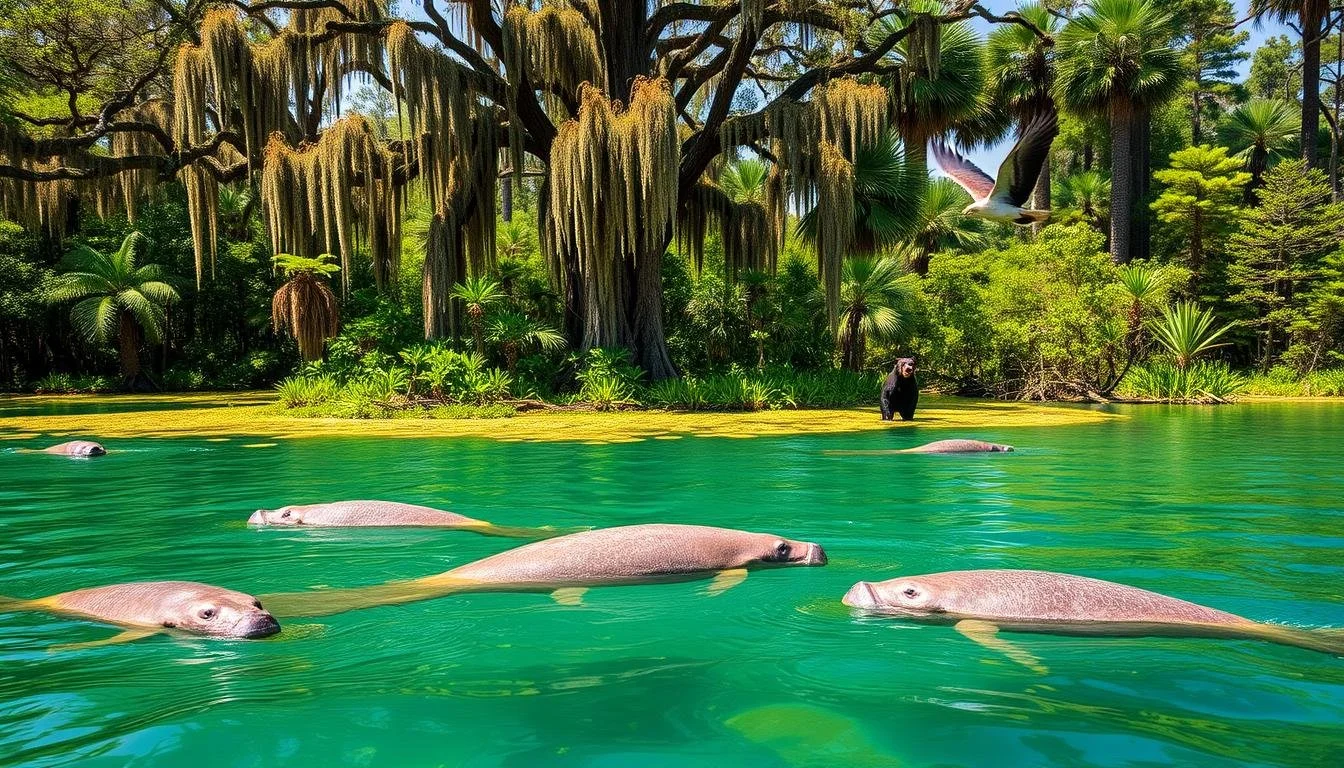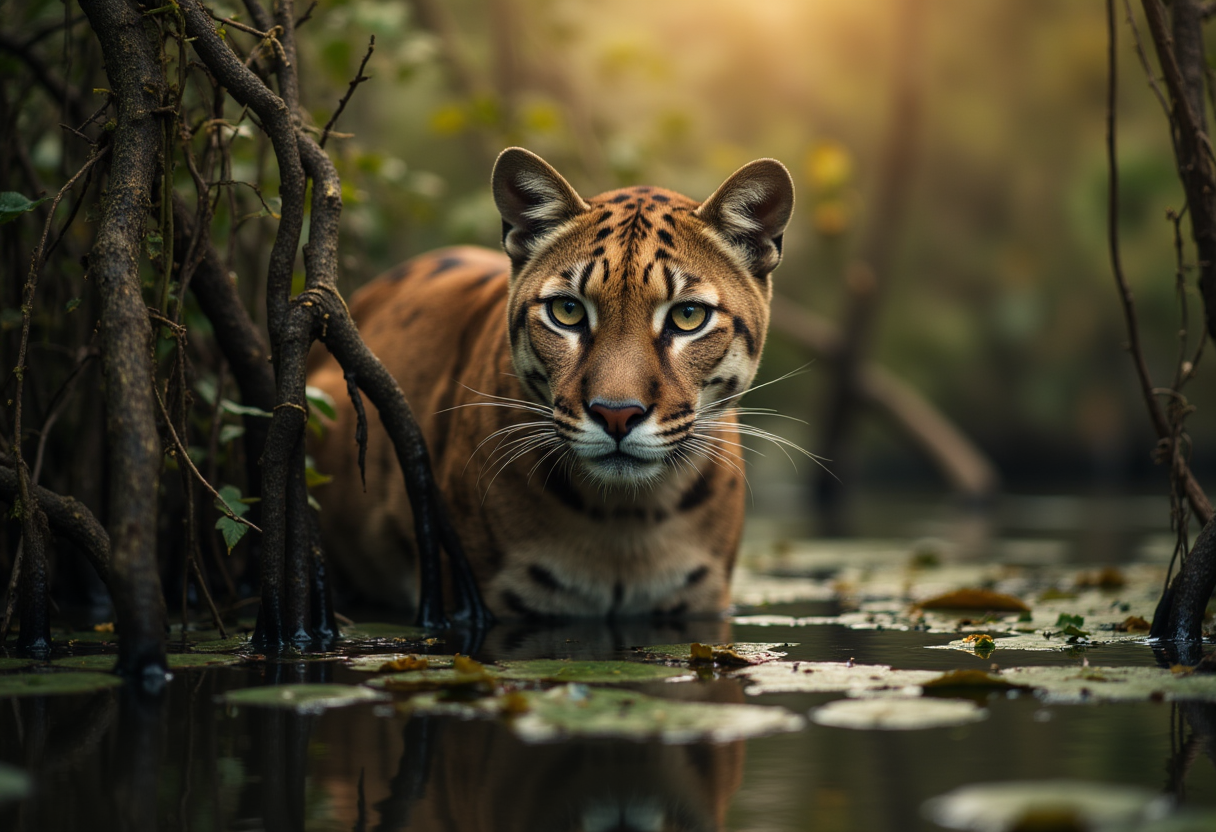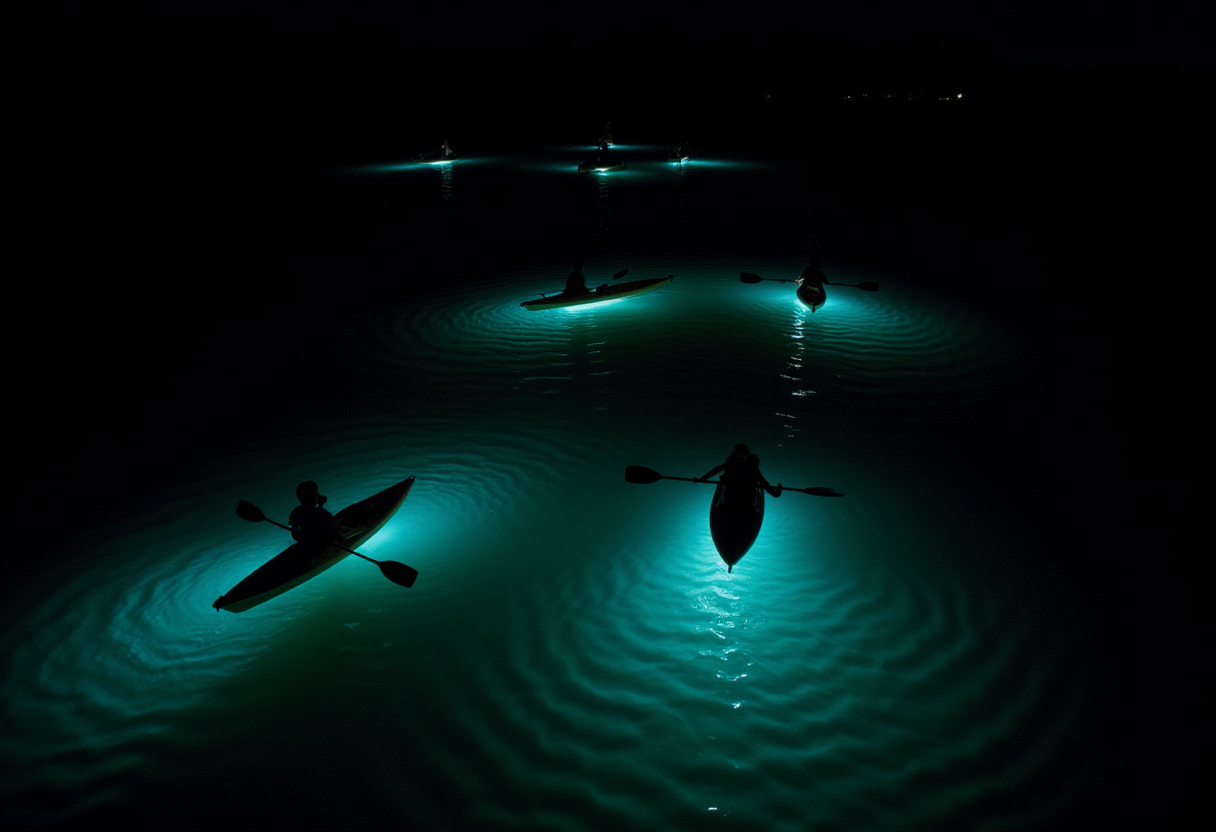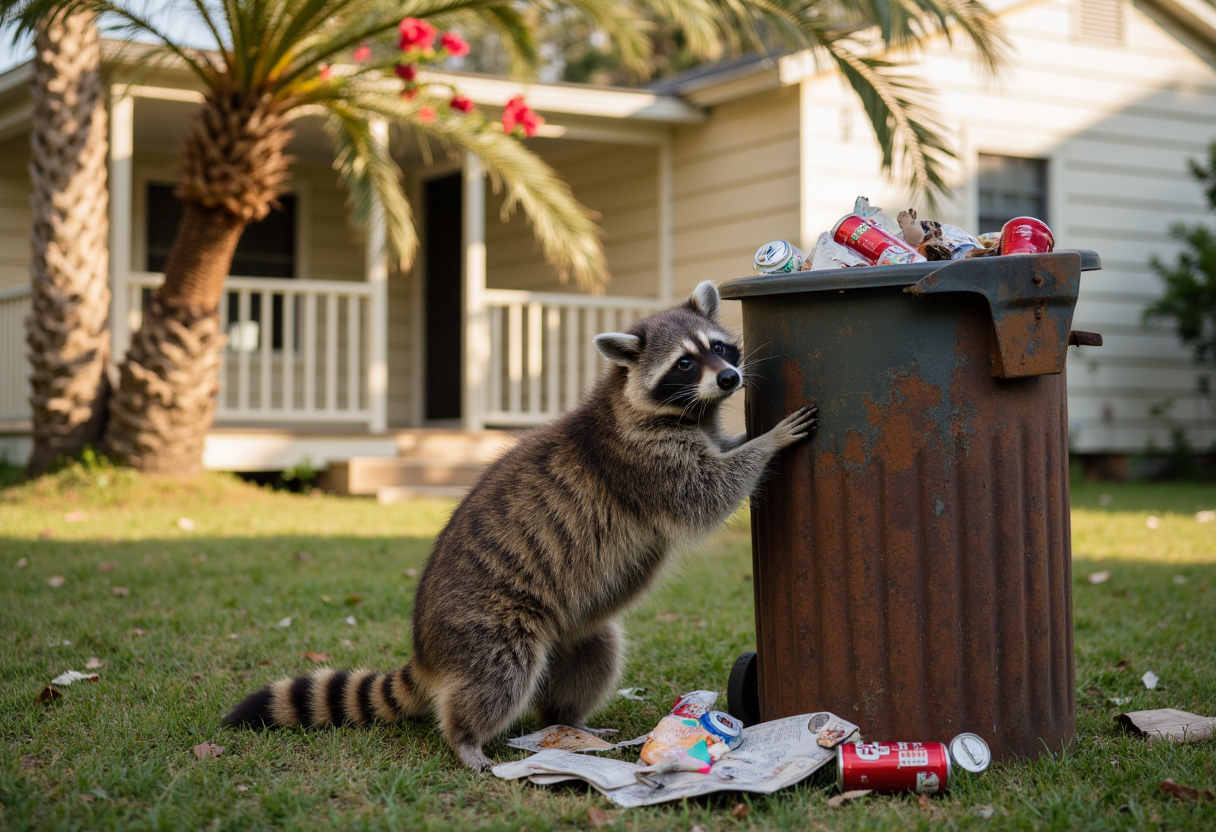🌴 Florida’s Wildlife Wonders: Strange Creatures
What's the most unexpected creature you might spot in the Sunshine State? Is it the rare Florida panther roaming the forests or the manatees gliding through the waters?
Welcome to the wild side of Florida! We're excited to take you on a journey through the state's fascinating array of native Florida wildlife. From the Everglades to the coastlines, Florida is a haven for diverse ecosystems and the creatures that call them home.
Wildlife
As we explore the wonders of Florida's wildlife diversity, we'll highlight the unique species, conservation efforts, and the best places to experience it all. Buckle up and get ready to discover the magic of Florida's natural world!
Key Takeaways
Discover the unique species that call Florida home
Learn about the conservation efforts protecting Florida's wildlife
Explore the best places to experience Florida's natural wonders
Understand the importance of preserving Florida's ecosystems
Get ready for an adventure through the Sunshine State's diverse landscapes
The Diverse Ecosystems of Florida
Florida's ecosystems are as diverse as they are fascinating, ranging from the unique wetlands of the Everglades to the sun-kissed coastal habitats. This diversity is what makes Florida a haven for wildlife enthusiasts and nature lovers alike.
Everglades: America's Unique Wetland
The Everglades is a vast and complex ecosystem that is teeming with life. It's a place where the air is thick with the sounds of birdsong and the rustling of leaves.
Plant Life and Water Systems
The Everglades is characterized by its unique plant life, including mangroves, sawgrass, and cypress trees. The water systems that flow through the Everglades are equally complex, with a delicate balance between freshwater and saltwater.
Ecological Importance
The Everglades plays a critical role in supporting Florida's wildlife, providing a habitat for numerous species of birds, fish, and mammals. As one expert notes, "The Everglades is not just a wetland, it's a lifeline for many species."
Coastal Habitats and Barrier Islands
Florida's coastal habitats and barrier islands are another key component of its diverse ecosystems. These areas are dynamic and constantly changing, shaped by the forces of wind and waves.
Pine Forests and Scrublands
In addition to the Everglades and coastal habitats, Florida is also home to pine forests and scrublands. These ecosystems are characterized by their unique plant species and are home to a variety of wildlife, including the endangered Florida panther.
Florida's Remarkable Wildlife Diversity
From the Everglades to the Keys, Florida's remarkable wildlife diversity is a treasure trove of natural wonders. As we explore the Sunshine State's ecosystems, we find a complex interplay between native and invasive species, with seasonal patterns that shape the wildlife landscape.
Native vs. Invasive Species
Florida's native species, such as the Florida panther and the Key deer, are an integral part of the state's identity. However, the introduction of invasive species like the Burmese python and the lionfish has disrupted the delicate balance of the ecosystems. Invasive species can outcompete native wildlife for resources, alter habitats, and even lead to population declines. Efforts to control invasive species are underway, but it's a challenging task that requires continued vi
Seasonal Wildlife Patterns
The changing seasons bring about significant changes in Florida's wildlife patterns. Migration patterns, breeding seasons, and food availability all play a role in shaping the state's wildlife diversity. For example, the manatees migrate to warmer waters during the winter months, while the sea turtles nest on the beaches during the summer. Understanding these patterns is crucial for conservation efforts.
Biodiversity Hotspots
Florida is home to several biodiversity hotspots, including the Everglades and the Florida Keys. These areas support a wide range of plant and animal species, many of which are found nowhere else in the world. Conservation efforts are focused on protecting these hotspots, which are critical to maintaining the state's wildlife diversity.
Biodiversity HotspotLocationNotable SpeciesEvergladesSouth FloridaFlorida panther, alligator, manateeFlorida KeysOff the coast of southern FloridaKey deer, sea turtles, coral reefsPine FlatwoodsThroughout FloridaGopher tortoise, indigo snake, red-cockaded woodpecker
Magnificent Mammals of the Sunshine State
Florida's wild heart beats strong with its magnificent mammals, from the elusive Florida panthers to the gentle manatees. These creatures are a big part of what makes Florida's wildlife so special, and we're excited to share their stories with you.
Florida Panthers: The Endangered Icons
The Florida panther is an iconic symbol of the state's wild beauty, but it's also one of its most endangered. With conservation efforts underway, there's hope for the future of these majestic cats.
Conservation Status and Challenges
Florida panthers are listed as endangered, with habitat loss and fragmentation being major threats. Conservation efforts focus on protecting and restoring habitats, as well as educating the public about the importance of preserving these magnificent creatures.
Where to Spot Florida Panthers
If you're lucky, you might catch a glimpse of a Florida panther in the wild, particularly in areas like Big Cypress National Preserve or Fakahatchee Strand Preserve State Park. Remember to keep a safe distance and respect their habitat.
LocationBest Time to VisitTips for SpottingBig Cypress National PreserveEarly morning or late afternoonLook for panthers in areas with dense vegetationFakahatchee Strand Preserve State ParkDawn or duskBring binoculars for a closer look without disturbing
Manatees: Gentle Giants of Florida Waters
Manatees are gentle giants that call Florida home, particularly during the colder months. These large aquatic mammals are a delight to observe, and there are several places where you can see them up close.
"Manatees are not just incredible creatures; they're also an important part of Florida's ecosystem, helping to maintain the health of our waterways."
Key Deer and Other Native Mammals
Florida is home to a variety of native mammals, including the Key deer, a small subspecies of white-tailed deer found only in the Florida Keys. Other native mammals include the bobcat, the river otter, and the Florida black bear.
Each of these mammals plays a vital role in Florida's ecosystem, and learning about them can deepen our appreciation for the state's natural beauty.
Spectacular Bird Species and Migrations
As we explore Florida's diverse ecosystems, we're treated to a spectacular display of birdlife, from wading birds to raptors. The state's unique position as a peninsula surrounded by warm waters makes it a critical stopover for migratory birds and a year-round home to many native species.
Wading Birds of the Wetlands
Florida's wetlands are a haven for wading birds, with their long legs adapted for wading through shallow waters in search of fish and other aquatic prey. Among these, the roseate spoonbill and various species of ibises are standout examples.
Roseate Spoonbills and Ibises
Florida Wildlife Conservation
The roseate spoonbill is a sight to behold, with its bright pink plumage and distinctive spoon-shaped bill. Ibises, with their curved bills, are often seen probing the mud for crustaceans and insects. These birds are not just beautiful to watch; they also play a crucial role in the ecosystem.
Herons and Egrets
Herons and egrets are other common wading birds found in Florida's wetlands. The great egret, with its snowy white plumage, is a common sight, while the great blue heron is notable for its size and striking blue-gray feathers. These birds are known for their elegant hunting techniques, often standing still for long periods waiting for prey.
wading birds
Raptors and Birds of Prey
Florida is also home to a variety of raptors and birds of prey, including hawks, eagles, and ospreys. These birds are apex predators, playing a vital role in maintaining the balance of the ecosystem. The osprey, with its distinctive nesting platforms, is a common sight near coastal areas, diving into the water to catch fish.
Migratory Patterns and Seasonal Visitors
Many bird species migrate through Florida, taking advantage of its geographical location to rest and refuel. Understanding these migratory patterns can help birdwatchers plan their outings to maximize their chances of spotting a variety of species.
Bird Species Migration Period Common Locations Roseate Spoonbill Year-round Everglades, coastal wetlands Osprey March to September Coastal areas, lakes, and rivers Warblers Spring and Fall Woodlands, backyards with bird feeders
By appreciating and understanding the diverse bird species and their migrations, we can better support conservation efforts and enjoy the rich birdlife that Florida has to offer.
Reptiles and Amphibians: Florida's Prehistoric Residents
From the swamps to the beaches, Florida's diverse landscapes are inhabited by an array of reptiles and amphibians that are as fascinating as they are ancient. These creatures, often referred to as "living dinosaurs," have been thriving in Florida's ecosystems for millions of years, playing crucial roles in the balance of nature.
Alligators and Crocodiles: Living Dinosaurs
Florida is one of the few places in the world where you can find both alligators and crocodiles coexisting. The American alligator is a common sight in freshwater environments, while the American crocodile prefers the brackish waters of mangrove swamps and saltwater habitats.
Safety Tips for Alligator Country
When venturing into alligator country, it's essential to be aware of your surroundings. Here are some safety tips:
Keep a safe distance from bodies of water, especially at dawn and dusk when alligators are most active.
Never feed alligators or other wildlife.
Keep pets on a short leash and away from water edges.
Sea Turtles and Their Nesting Beaches
Florida's beaches are crucial nesting grounds for several species of sea turtles, including the loggerhead, green turtle, and leatherback. These gentle giants migrate thousands of miles to lay their eggs on the same beaches where they were born.
Sea Turtle SpeciesNesting SeasonConservation StatusLoggerheadMay to OctoberVulnerableGreen TurtleJune to SeptemberEndangeredLeatherbackMarch to JulyVulnerable
Snakes, Lizards, and Frogs of Florida
Beyond alligators and sea turtles, Florida is home to a diverse array of snakes, lizards, and frogs. From the venomous Coral Snake to the harmless Gopher Frog, each species plays a vital role in the ecosystem.
Some common species include:
The Green Iguana is a large, invasive lizard.
The Cuban Tree Frog is known for its loud calls.
The Cottonmouth, a venomous snake found in wetlands.
Marine Wildlife Wonders of Florida's Coasts
Florida's coastline is a treasure trove of marine life, teeming with creatures that'll make you smile. As we explore the marine wildlife wonders of Florida's coasts, we'll dive into the fascinating world of dolphin populations and their intriguing behaviors.
Dolphin Populations and Behaviors
Dolphins are a common sight in Florida's waters, with bottlenose dolphins being the most frequently spotted species. These intelligent creatures are known for their playful antics and complex social behaviors. We can observe them swimming in groups, communicating with clicks and whistles, and even surfing the waves alongside boats.
Coral Reef Ecosystems and Their Inhabitants
Florida's coral reefs are vibrant ecosystems that support a vast array of marine life. These underwater cities are home to an incredible diversity of fish species, from the tiny damselfish to the majestic parrotfish. The reefs also host a variety of invertebrates, including sea stars, sea urchins, and colorful corals.
Fish Species Diversity
The coral reefs off Florida's coast are a hotspot for fish diversity, with species like angelfish, butterflyfish, and groupers calling the reef home. This diversity is crucial for the health of the reef ecosystem, as each species plays a unique role in the complex web of relationships within the reef.
Invertebrates and Reef Health
Invertebrates like corals, sea fans, and sea sponges are the backbone of the reef ecosystem. They provide habitat for countless other species and help maintain the balance of the reef. However, these invertebrates are often sensitive to changes in water quality and temperature, making reef health a critical concern.
Seasonal Visitors: Whale Sharks and Right Whales
Florida's coastal waters also play host to several seasonal visitors, including the majestic whale shark and the endangered North Atlantic right whale. These creatures migrate to Florida's waters to feed, breed, or give birth, making certain times of the year ideal for wildlife watching.
As we marvel at the marine wildlife wonders of Florida's coasts, it's clear that the state's marine ecosystems are not just fascinating – they're also fragile and in need of our protection. By understanding and appreciating these incredible ecosystems, we can work together to preserve them for future generations.
Top Wildlife Viewing Destinations in Florida
From the Everglades to the Keys, Florida's top wildlife viewing destinations are a nature lover's paradise. The Sunshine State is renowned for its rich biodiversity, and there are numerous protected areas where visitors can experience the best of Florida's wildlife.
National Parks and Preserves
Florida's national parks are a treasure trove of wildlife viewing opportunities. Two of the most notable parks are:
Everglades National Park: This vast wetland is home to alligators, manatees, and numerous bird species.
Biscayne National Park: Explore the coral reefs and mangrove forests to spot dolphins, sea turtles, and colorful fish.
portrait of a majestic Florida Panther, partially concealed amidst the lush, emerald-green foliage of a misty wetland environment,
Everglades National Park
The Everglades is a unique ecosystem that supports a wide variety of wildlife. Take an airboat tour or hike through the sawgrass marshes to spot alligators, birds, and other animals.
Biscayne National Park offers a glimpse into Florida's marine biodiversity. Snorkel or dive in the crystal-clear waters to see the coral reefs teeming with life.
Wildlife Refuges and Sanctuaries
In addition to national parks, Florida is home to many wildlife refuges and sanctuaries that provide a safe haven for native species.
J.N. "Ding" Darling National Wildlife Refuge: Located on Sanibel Island, this refuge is a haven for birdwatchers, with over 300 species documented.
Merritt Island National Wildlife Refuge: This refuge is a nesting ground for sea turtles and a stopover for migratory birds.
J.N. "Ding" Darling National Wildlife Refuge
The J.N. "Ding" Darling Refuge is a must-visit for bird enthusiasts. Take a driving tour through the refuge to spot birds, alligators, and other wildlife.
Merritt Island National Wildlife Refuge
Merritt Island is a critical habitat for many species. Visitors can explore the refuge by car or on foot to see a variety of wildlife, including manatees and dolphins.
Urban Wildlife Viewing Opportunities
You don't have to leave the city to experience Florida's wildlife. Many urban areas have parks and green spaces that are home to a surprising variety of animals.
"Urban wildlife viewing can be just as exciting as visiting a national park. Keep an eye out for birds, turtles, and even alligators in your local park." - Local Wildlife Expert
Conservation Efforts Protecting Florida's Wildlife
Conservation is at the forefront of preserving Florida's natural heritage, with various initiatives aimed at protecting its unique wildlife. Florida's diverse ecosystems, from the Everglades to the coral reefs, are home to a wide range of species, many of which are found nowhere else on Earth.
Endangered Species Recovery Programs
One of the critical conservation efforts in Florida is the recovery programs for endangered species. The Florida panther, manatee, and sea turtles are among the species that have benefited from these programs. Conservationists are working tirelessly to monitor populations, protect habitats, and educate the public about the importance of these species.
Habitat Restoration Initiatives
Habitat restoration is another vital aspect of conservation in Florida. Initiatives to restore the Everglades, revitalize coastal ecosystems, and preserve pine forests are underway. These efforts not only help to protect wildlife habitats but also contribute to the overall health of the environment.
Florida wildlife conservation
How Visitors Can Support Conservation
Visitors to Florida can play a significant role in supporting conservation efforts. By adopting responsible wildlife viewing practices and supporting conservation organizations, tourists can contribute to the protection of Florida's wildlife.
A striking image of a bioluminescent kayak tour at night, with kayakers paddling through glowing water in the Indian River Lagoon.
Responsible Wildlife Viewing Practices
Responsible wildlife viewing is crucial for minimizing the impact on wildlife. This includes keeping a safe distance, not feeding wildlife, and respecting their habitats.
Supporting Conservation Organizations
Several organizations are dedicated to conservation efforts in Florida. Supporting these organizations through donations or volunteering can make a significant difference.
Conservation Organization Area: Ways to Support The Nature Conservancy Habitat restoration, species protection- Donations, volunteering. Defenders of Wildlife, Endangered species, habitat preservationMembership, advocacy campaigns, Florida Wildlife Federation, Conservation education, habitat restoration, Donations, membership
By working together and supporting conservation efforts, we can ensure that Florida's wildlife continues to thrive for generations to come.
Conclusion: Embracing and Preserving Florida's Natural Heritage
As we wrap up our journey through Florida's wildlife wonders, we're reminded of the Sunshine State's incredible natural heritage. From the Everglades to the coral reefs, Florida's diverse ecosystems support a vast array of wildlife, making it a true gem in the United States.
Preserving Florida's natural heritage requires a collective effort to support wildlife conservation. We can make a difference by supporting conservation efforts, such as protecting endangered species and restoring habitats. By working together, we can ensure that Florida's wildlife continues to thrive for generations to come.
So, let's make a commitment to protect Florida's natural heritage and support wildlife conservation. Whether you're a resident or just visiting, you can play a role in preserving the state's incredible wildlife and ecosystems. By embracing and preserving Florida's natural heritage, we can continue to enjoy the beauty and wonder of the Sunshine State.
FAQ
What are the best places to spot Florida panthers?
Florida panthers can be spotted in the wild, particularly in the Everglades National Park and Big Cypress National Preserve. These areas provide a natural habitat for these majestic creatures.
How can I support conservation efforts in Florida?
You can support conservation efforts by visiting national parks and wildlife refuges, such as J.N. "Ding" Darling National Wildlife Refuge and Merritt Island National Wildlife Refuge, and by donating to reputable conservation organizations.
What are some safety tips for visiting alligator country?
When visiting alligator country, it's essential to keep a safe distance from bodies of water, especially during dawn and dusk when alligators are most active. Never feed alligators, and be aware of your surroundings.
What types of wildlife can I expect to see in Florida's coastal areas?
Florida's coastal areas are home to a diverse range of marine wildlife, including dolphins, sea turtles, and coral reefs teeming with fish species and invertebrates.
Are there any urban wildlife viewing opportunities in Florida?
Yes, many Florida cities offer urban wildlife viewing opportunities, such as birdwatching in city parks or spotting manatees in urban waterways.
How can I responsibly view wildlife in Florida?
scene of a raccoon in a Florida suburban backyard, rummaging through a rusty, overflowing garbage can with a bemused expression, as if it's uncovering a treasure trove of secrets.
To responsibly view wildlife, keep a safe distance, never feed or touch animals, and be aware of your surroundings. Support responsible wildlife viewing practices and conservation organizations.
What are some of the most endangered species in Florida?
Some of the most endangered species in Florida include the Florida panther, Key deer, and sea turtles. Conservation efforts are in place to protect these species.
Can I visit Florida's wildlife refuges and sanctuaries?
Yes, many of Florida's wildlife refuges and sanctuaries, such as J.N. "Ding" Darling National Wildlife Refuge and Merritt Island National Wildlife Refuge, are open to visitors and offer a unique opportunity to experience Florida's wildlife.
Earl Leee
Florida Unwritten.com

